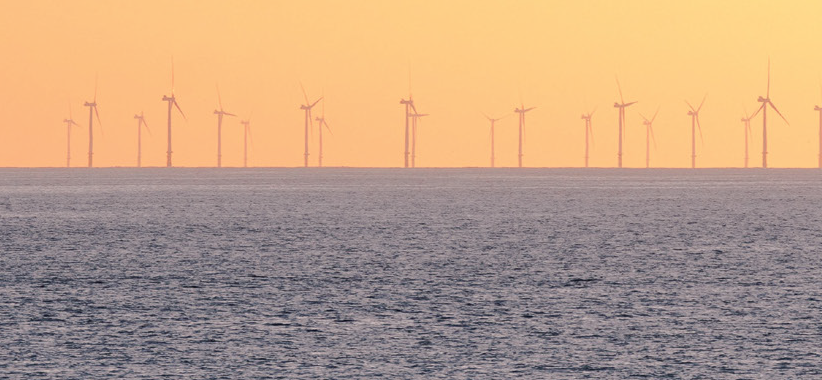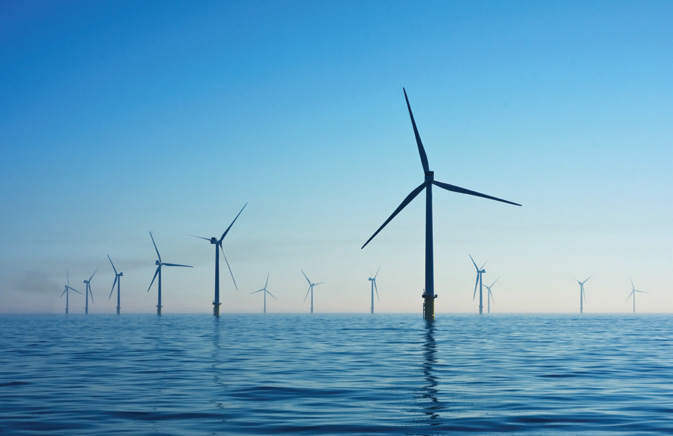What is offshore wind energy?
Offshore wind energy involves generating electricity from wind turbines in the ocean. These turbines capture wind energy and convert it into electricity, which is then transmitted to the shore via cables under the seabed.
Offshore wind energy has been used around the world since 1991 and increases globally year on year.
Are there any impacts to whales from offshore wind farms?
Like any ocean activity or operation, offshore wind farms have the potential to impact whales through the generation of noise during construction activities and vessel movements during the operation phase. By carefully considering whale habitats and behaviours during site selection, and through robust environmental assessment processes that include mitigation, monitoring, and adaptive management measures, any impacts on whale behaviour are likely to be short-term and localised.
Do offshore wind farms harm whales?
There is no evidence to suggest that offshore wind farms will kill whales in Australia or that they are killing whales anywhere else in the world. Scientific investigations have found no link between whale deaths and offshore wind activities. Benjamin Laws, deputy chief for permits and conservation with the US National Oceanic and Atmospheric Administration Fisheries Office of Protected Resources, told a media teleconference on East Coast whale strandings: “I want to be unambiguous: There is no information supporting that any of the equipment used in support of offshore wind development could directly lead to the death of a whale.”1
There is no information supporting that any of the equipment used in support of offshore wind development could directly lead to the death of a whale.
1 NOAA Fisheries media teleconference on East Coast whale strandings: January 18, 2023
2 EPBC Act Migratory Species List: SPRAT EPBC Migratory List (environment.gov.au)
Are there any regulations in Australia to protect whales from offshore wind development?
Whales are migratory species and are protected under the Environment Protection and Biodiversity Conservation Act 1999 (EPBC Act). Under the EPBC Act, any activities that may have a significant impact on listed whale species or their habitats require assessment and approval. All cetaceans (whales, dolphins and porpoises) are protected in Australian waters by the Australian Whale Sanctuary and are listed as endangered, vulnerable, migratory or marine species under the EPBC Act, making them an important focus of these assessment processes.2 Listed endangered whales such as the southern right whale and blue whale have recovery plans in force under the EPBC Act to ensure all threats are effectively managed. The Federal Environment Minister must not act inconsistently with a recovery plan in deciding whether to approve the taking of an action under the EPBC Act. Offshore wind projects are required to consider relevant laws and other requirements as part of their project development process.
The biggest threats to whales and dolphins globally
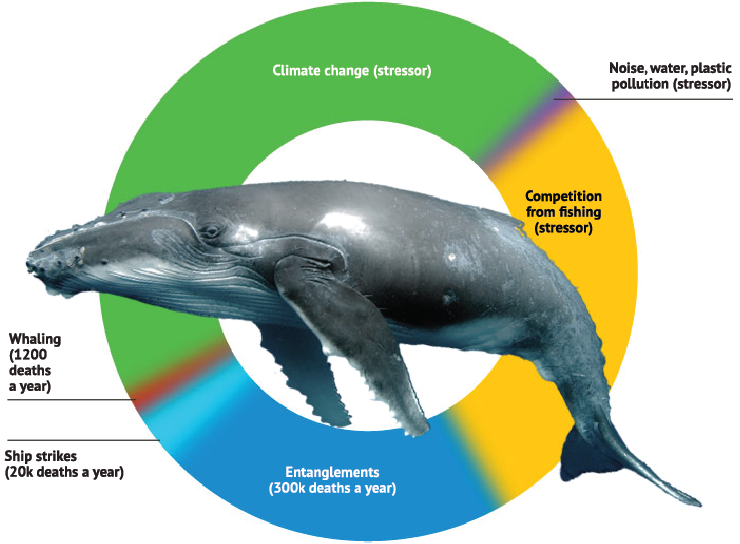
What measures can be taken to reduce the impact of offshore wind farms on whales?
Mitigation measures to reduce impact on whales may include scheduling work outside of seasons for biologically important behaviours, use of noise reduction technologies such as bubble curtains during construction activities, reducing vessel speeds, and the use of marine mammal observers during survey works and construction.3 Each project will apply mitigations appropriate to the risks to whales at their specific location, considering the different designs and construction methodologies.
Can whales get caught in floating transmission cables or mooring ropes from floating offshore wind farms?
Floating offshore wind transmission cables and mooring lines can pose three types of entanglement risks for marine life: primary entanglement (directly ensnaring animals); secondary entanglement (ocean debris like fishing lines getting caught); and tertiary entanglement (marine fauna getting caught in tangled debris). However, the risk to whales of being caught in floating offshore wind transmission cables is considered very low.4 Although primary entanglement is extremely unlikely due to the size and structure of the cables, developers must proactively monitor and mitigate these risks. They will draw upon resources such as the US’ Natural Resources Defence Council, which has developed monitoring and mitigation recommendations to reduce entanglement risks in floating offshore wind projects.5
Overseas, modern cable design and protection techniques, such as placing cables beneath the seabed, have significantly reduced entanglement risks. Ongoing monitoring and research are encouraged to understand all potential impacts of offshore wind infrastructure.
Comparatively, research by the International Whaling Commission suggests that over 300,000 whales and dolphins die annually due to entanglement in fishing gear and by being unintentionally caught."
Will noise during the construction period of an offshore wind farm impact whales?
Some types of fixed-bottom foundations need to be driven into the seabed (e.g. monopiles) and can produce loud noises that may temporarily disturb whales; however, appropriate mitigation measures such as double bubble curtains and scheduling work outside of biologically important seasons can minimise these impacts. The environmental assessment process required under the EPBC Act involves detailed assessment of measures to reduce noise emissions and limit disturbance to biologically important whale behaviour.
During offshore wind construction, several advanced noise mitigation systems are used to protect marine life including whales. These include double bubble curtains, which create a barrier of bubbles to dampen sound waves, and acoustic deterrent devices that emit sounds to encourage marine animals to move away from the construction area.6 Additionally, soft-start procedures gradually increase noise levels, allowing marine animals to vacate the area before noise becomes disruptive.7 Australia will benefit from these innovations by adopting these proven technologies to minimise impacts on marine life from offshore wind projects.
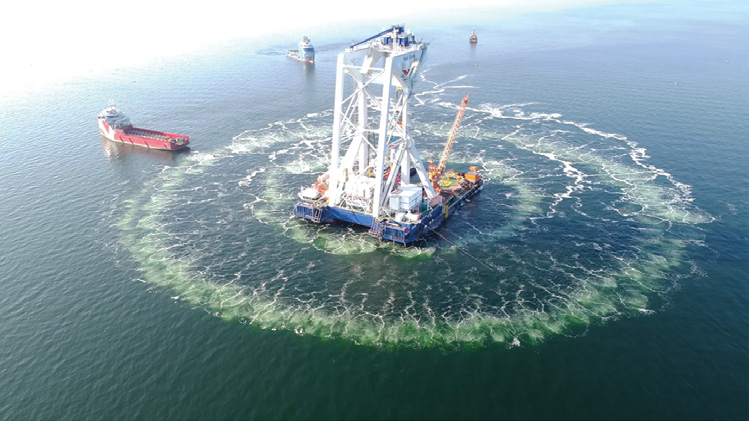
Source: Creating a curtain of bubbles around the area where an offshore wind turbine is being installed can help to minimise the noise - BBC
3 Underwater noise impacts: https://www.dcceew.gov.au/energy/renewable/offshore-wind/offshore-wind-facts#offshore-wind-farms-will-have-measures-in-place-to-address-risks-to-whales-and-seabirds
4 https://www.northcoastoffshorewind.org/faq-offshore-wind-impacts-to-whales-and-marine-mammals
5 New Recommendations Reduce Floating Wind Entanglement Risk
6 Modeling the noise mitigation of a bubble curtain | The Journal of the Acoustical Society of America | AIP Publishing
7 Use ‘soft start’ procedures to deter marine and freshwater mammals to reduce noise exposure - Conservation Evidence
The transition to clean energy, from ageing coal-fired power stations is ultimately crucial to the protection of marine life and preserving their habitats.
Does vessel movement during the construction of an offshore wind farm pose a risk to whales?
Like all shipping movements, vessel strikes during the construction and operation of offshore wind projects can pose a risk to whales. To mitigate this risk, developers must adhere to strict regulations, such as speed restrictions and designated vessel routes, to minimise the chances of collisions. In Australia, proponents are required to implement measures like real-time monitoring and seasonal construction windows to protect marine life. Additionally, trained crew members will maintain constant watch during whale migration periods to monitor the ocean around vessels and offshore construction activities for the presence of marine mammals.
Does offshore wind protect whales from climate change?
Climate change is the biggest threat to marine ecosystems, including through changes in ocean temperatures, prey availability, and migratory patterns, all of which can affect whale populations.8 Offshore wind farms can help protect whales from the impacts of climate change. By generating renewable energy, offshore wind farms reduce reliance on fossil fuels, which in turn reduces greenhouse gas emissions and mitigates the effects of climate change. The transition to renewable energy is crucial for protecting marine life and preserving their habitats.9
8 whales-their-future-is-our-future.pdf
9 Climate change:
https://www.greenpeace.org.au/article/the-low-down-on-whales-and-wind-farms/ https://www.fisheries.noaa.gov/new-england-mid-atlantic/marine-life-distress/frequent-questio ns-offshore-wind-and-whales
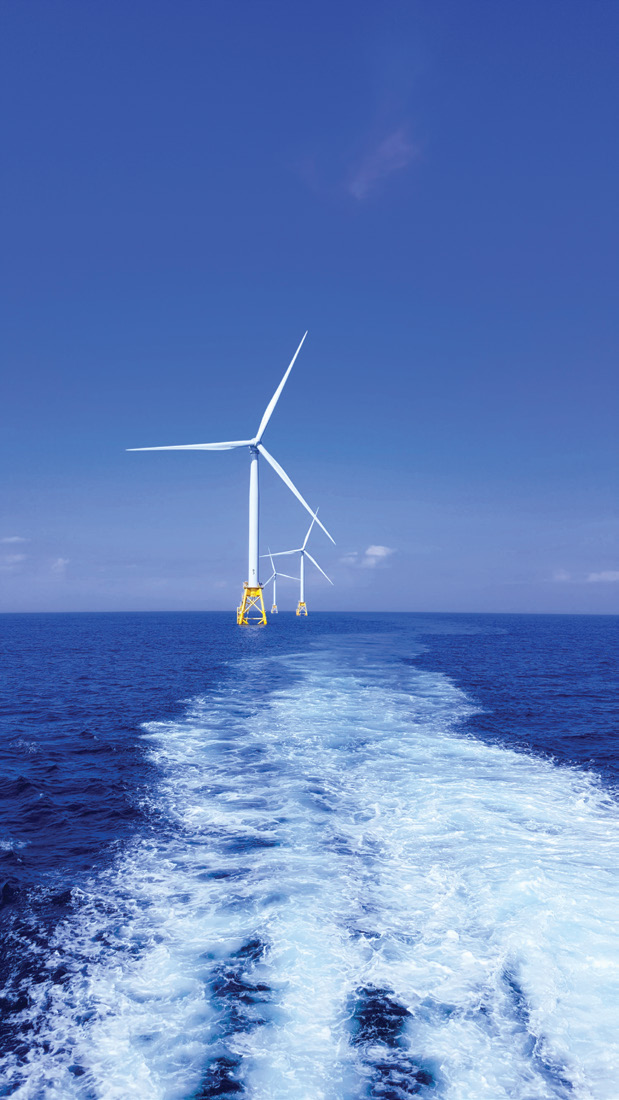
Top 5 offshore wind facts
Offshore ocean winds are strong and consistent
complementing onshore renewable resources and diversifying Australia's energy mix
Australia has world class offshore wind resources
with wind speeds and ocean depths comparable to Europe's most advanced offshore wind areas
Renewable energy, such as offshore wind, is the most effective tool to protect our marine life from the effects of climate change
The Australian offshore wind industry is already underway
with 25 gigawatts of feasibility licences awarded across 12 projects in the Gippsland offshore wind area, enough to power 13.5 million Australian homes for a year
Offshore wind energy will generate electricity close to where it’s needed
87% of Australians live within 50km of the ocean, requiring less new transmission to be built
